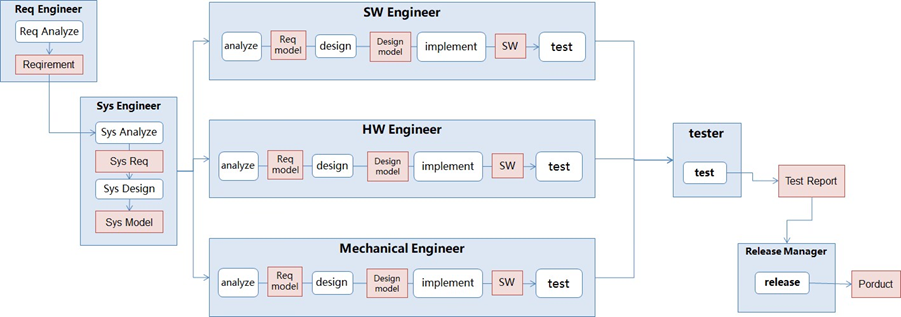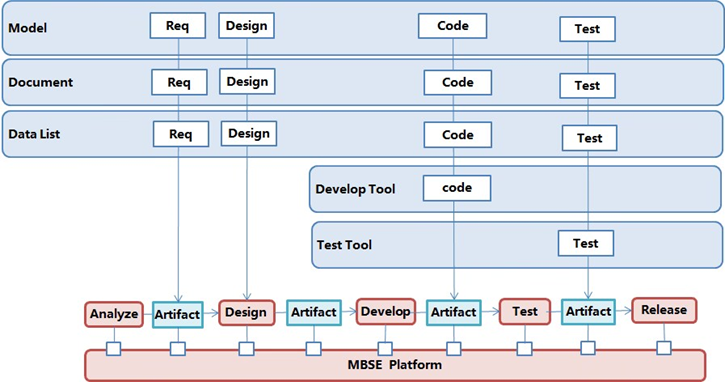|
|
| |

|
|
| |
| Tool Directory |
| Build the MBSE Toolchain with the power of EA: Model Driven Development, Requirements Management, Quality Management, Simulation Verification, Continuous Integration |
Tool
|
Work Description |
| EA |
Support full cycle Modeling: System Modeling (SysML), Software Modeling (UML), Real-time Analysis Design Modeling (MARTE), Business Analyst Modeling (BABOK), Workflow Modeling (BPMN), DataModel Enterprise Architecture (Archimate), Decision Modeling DMN, Policy Modeling, Geographic Information Modeling (GML), Interaction Modeling (IFML).
Various Model Frameworks are available: NIEM, DoDAF, UPDM, UAF, DDS, Zakaman, AutoSAR |
| iSpace |
The Requirements are managed Based on the Model, and the Requirements Model, Design Model, code Model and Test Model are displayed in the form of a list of items. All the Models of System Engineering can be associated and tracked in the form of a list, including Requirements, Design, code and Test. |
| Iwork |
Research and Development Management tools to support project Management, Requirements Management, Design Management, Test Management, quality Management, consumption Management. |
| DocGenerator |
Model-Based document generator for 100% automated generation of documents: System Requirements documents, System Design documents, Software Requirements, Software Design documents. |
| Integrator |
Continuous Integration platform can automatically schedule various tasks of continuous Integration through workflow: Software code inspection, build, unit Testing, Integration Testing, System Testing, and can centrally manage various artifacts and customize unified quality reports. |
| iPerson |
The ability Model of various staff roles can be established, and then the ability evaluation criteria and question bank can be established for the ability items of each role. The staff can conduct the ability evaluation, develop training plans for the staff, and provide courses and learning materials. |
| OpenModelica |
For the Analysis and Design of various physical Systems, Modelica can be used to Model various physical units, algorithm logic and interface relations, generate code and simulation verification. |
| Matlab simulink |
Using module diagram to Model System structure unit, using state machine to describe control logic, using algorithm module to Model algorithm function, can generate code, simulation and verification. |
| OSate |
To Model the operating Architecture of the System, including CPU, memory, Process , thread and data flow, you can use AADL Modeling, code generation, simulation. |
| Protel |
Electronic circuits can be analyzed, Designed and Modeled, and electronic devices, circuit nodes and lines can be Modeled using PCB, and codes and simulations can be generated. |
|
|
| MBSE Service Directory |
| Provide database interface: can directly connect to the physical database, data Modeling and database instance synchronization. |
|
|
|
| What problems do you help users solve? |
| The Software Development Process is as follows: |
| |
 |
| |
The entire Development Process involves multiple teams: Requirements, Development, Testing, and operations. There are often the following problems:
- Process: The whole Development Process is not coherent, each stage is disconnected, resulting in low work efficiency.
- Deliverables: Each stage has related deliverables, in various forms, with documents, Models, code, etc., making it difficult to track and manage.
- Quality: lack of unified quality view, resulting in scattered quality Management, quality assurance effect is not good.
- In terms of personnel: there is a lack of corresponding views from work tasks to related skills. Although my work ability is insufficient, it is difficult to find a clear direction for improvement.
- Tools: there are professional tools in every link, which are expensive to buy and learn, difficult to effectively apply, and the work efficiency is low without tools.
|
| |
| The goal of R&D Management System is to improve the final product quality and efficiency, the above five aspects of the problem is not isolated, through one or two aspects of improvement is often half the result. Software Development integrated Management System and platform can provide you with a complete solution, from the people, Process , deliverables, tools, quality five aspects to solve the problem, really improve the efficiency and quality of research and Development. |
| |
| The integrated Management System describes, builds, and improves your R&D Management System from five perspectives, and provides the relevant tools and Engineering data space for full cycle Management and tracking. |
| |
| Solution |
| Software Development integrated Management System and platform to provide solutions from a full perspective, involving the following five aspects of view: |
| Dimensionality |
Goal |
Method |
| 1. Process |
Throughout the whole Process cycle |
Straighten out the full cycle Process Model: Requirements - Design - Development - Test - Delivery. Improve Process efficiency. |
| 2. Data |
Correlate various Engineering data |
Connect all kinds of Software Engineering data, track and manage them in a unified way, and improve the efficiency and quality of deliverables. |
| 3.Tools |
Multi-tool Integration |
The tools needed for various work are specialized, connected and concise, reducing the cost of tools, providing tool Integration, and improving the efficiency of tools. |
| 4.Quality |
Complete quality view |
Establish a complete quality view, relate various qualities, identify quality bottlenecks, and promote overall quality improvement. |
| 5.Personnel |
Job qualification and ability training |
Clarify the work of personnel, cultivate relevant skills, measure the work efficiency, and promote the work efficiency of personnel. |
|
| |
| Process Model opening |
Establish an executable Development Process for Model-driven Systems Engineering and Software Engineering Requirements:
- Because the entire Process involves multiple disciplines of Systems Engineering, Software, and hardware, Model-driven Systems Engineering (MBSE) is recommended for rigorous tracking.
- The Process should be oriented towards the actual work phase.
- Some of the work should be broken down or merged in consideration of specific tool use.
- It can be classified for different product Development characteristics and establish various types of Process guidelines.
|
| |
 |
| |
| |
| Engineering data association |
| The Engineering data of each link in the whole System Engineering is sorted out, various Engineering data are identified, the structure and relationship of data are analyzed, and the data Model is established. All kinds of Engineering data of Software Development are unified Modeling, and the schematic diagram is as follows: |
|

|
| Tool Integration |
| |
The whole Process Design of a variety of tools for Integration, Integration principle is:
- Based on the customer's existing tools, open up the interface between tools.
- Data association between various tools to achieve integrated Management.
- Build tool Integration interface to improve ease of use.
|
| |
| The various levels and Management of the tool are as follows: |
| |

|
| Develop a Management tool chain |
| Tool Name |
Function Introduction |
| iSpace |
Provides a unified workbench interface.
Provide document collaborative editing, Model file collaborative editing.
Group discussion, instant messaging. |
| iWork |
Provide System Development cycle Management: product Management, project Management, Requirement Management, Design Management, Test Management, change Management, bug Management, quality Management.
Provide product shelf, reuse Management.
People capability Management. |
| Visual Modeling Tool -EA |
You can build Requirements Models, data Models, Architecture Models, code Models, and Test Models.
Support for Model-driven Development, UML and Sys ML, as well as the Auto SAR Model Framework. |
| Code Management Tool |
Git, Subversion |
| Continuous Integration |
Jenkins,a continuous Integration tool, allows you to integrate other tools through scripts. |
| Code Check |
QAC,Gerrit,CppCheck |
| Unit Testing and Integration Testing |
TESSY ,TestSand,TestBed |
| Automated Test Tool |
Automated Test tool, can simulate the System operating environment, interface Testing. |
|
| |
| Pitaya Software Engineering technology center introduction |
Founded in 2001, Pitaya Software Engineering Technology Center is committed to providing complete Software Engineering technology solutions for IT research and Development teams, and has provided high-quality training for more than 2,000 enterprises and consulting on Software Engineering tools for more than 100 enterprises. Typical customers include:
- Byd Central Research Institute
- Gillicorion Corporation
- Continental Automotive Electronics
- Shanghai General Motors
- Desay Siway
- CATL
- Bosch Automotive Electronics
- Shenlong Automobile
- Fortelon Automotive Electronics
- Faw car
- Valeo Automotive Appliances
- Autoliv Automotive Electronics
- Flextronics
- United automotive electronics
- Natifu Drive System Co., LTD
|
| Pitaya Software has a strong interface Development ability for various Systems Engineering and Software Engineering tools, and has customized continuous Integration platform for customers, integrating various tools into one platform, including: Modeling, Requirements Management, code storage, code construction, automated Testing. |
|
| Pitaya Software Engineering (China's leading Software Engineering service provider) |
| Email:umlooo@hotmail.com |
|
|
|

|
|

